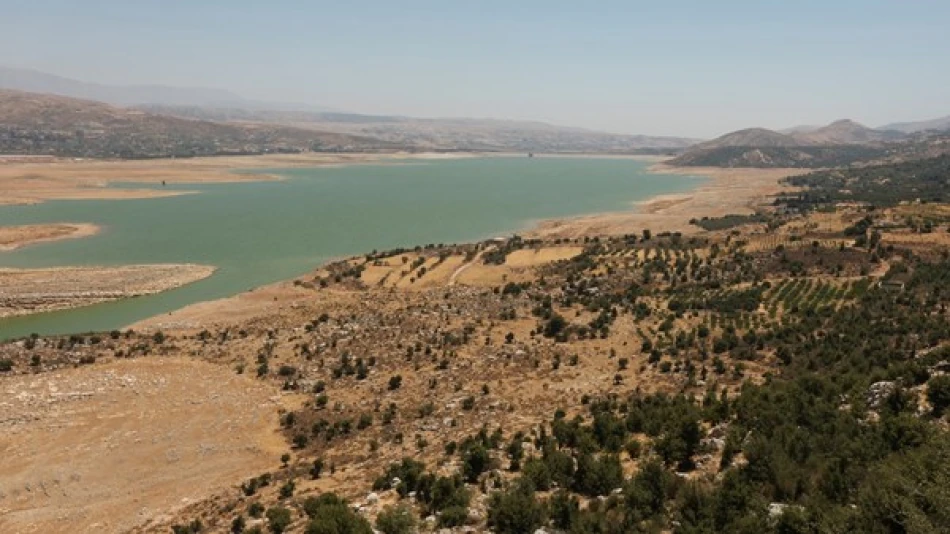
Lebanon Faces Unprecedented Drought Crisis, Raising Urgent Concerns
Lebanon's Lifeline Runs Dry: Worst Drought in History Cripples Nation's Water Supply
Lebanon is facing its most severe drought on record, with water levels in the country's largest reservoir plummeting to critical lows and forcing dramatic cuts to public water supplies. The crisis at Lake Qaraoun, fed by the vital Litani River, has effectively eliminated the nation's hydroelectric power generation while highlighting the intersection of climate change and infrastructure collapse in the Middle East.
A Water Crisis of Historic Proportions
The Litani River National Authority announced that water inflows to Lake Qaraoun during this year's rainy season reached only 45 million cubic meters—a staggering 87% drop from the annual average of 350 million cubic meters. This represents the lowest water levels ever recorded in Lebanon's primary water storage facility.
The situation is even more dire than the numbers suggest. While approximately 61 million cubic meters of water remain in the lake, severe pollution has rendered this supply unusable for human consumption, effectively leaving the reservoir functionally empty.
Surpassing Historical Drought Records
Sami Alawiyeh, head of the Litani River Authority, emphasized that current conditions exceed even the severe drought years of 1989-1991, previously considered Lebanon's worst water crisis in modern history. This comparison underscores the unprecedented nature of the current situation and suggests that traditional drought management strategies may prove inadequate.
The timing couldn't be worse for a nation already grappling with economic collapse, political instability, and the aftermath of the 2020 Beirut port explosion. Lebanon's infrastructure, weakened by years of underinvestment and mismanagement, now faces an additional environmental shock that threatens basic services.
Energy Security Takes Another Hit
The drought has forced the complete shutdown of hydroelectric power plants connected to the Litani River basin, eliminating a crucial source of renewable energy for a country already experiencing chronic electricity shortages. This development further strains Lebanon's energy grid, which typically provides citizens with only a few hours of electricity daily.
The loss of hydroelectric capacity forces greater reliance on expensive fuel imports, adding pressure to Lebanon's already depleted foreign currency reserves. For a nation whose currency has lost over 90% of its value since 2019, every additional energy cost compounds the economic crisis.
Daily Life Under Water Rationing
Government utilities have slashed water supplies in affected regions from 20 hours per day to fewer than 10 hours, forcing residents to adapt to severe rationing. This reduction affects millions of Lebanese citizens who already face challenges accessing basic services amid the country's broader infrastructure breakdown.
The water cuts disproportionately impact vulnerable populations who cannot afford private water deliveries or storage systems, potentially exacerbating social tensions in an already fragile society.
Regional Climate Patterns and Future Implications
Lebanon's drought reflects broader climate trends affecting the Eastern Mediterranean, where rising temperatures and changing precipitation patterns are reshaping water availability. Similar challenges face neighboring countries including Syria, Jordan, and parts of Turkey, suggesting that regional cooperation on water management may become increasingly critical.
The crisis also highlights the vulnerability of small, import-dependent economies to climate shocks. Unlike larger nations with diverse water sources and greater financial resources, Lebanon's limited geographic area and constrained fiscal capacity leave few alternatives when primary water sources fail.
Long-term Consequences for Recovery
The drought compounds Lebanon's existing challenges and may significantly delay any economic recovery efforts. Water scarcity affects agricultural productivity, industrial operations, and public health—all essential components of economic stability. International aid organizations and potential investors are likely to view water security as a critical factor in any future development plans.
The pollution of remaining water supplies points to deeper governance failures in environmental protection and infrastructure maintenance. Addressing both the immediate drought impacts and underlying water quality issues will require substantial investment and institutional reform—resources that remain scarce in Lebanon's current political and economic environment.
Most Viewed News

 Layla Al Mansoori
Layla Al Mansoori






